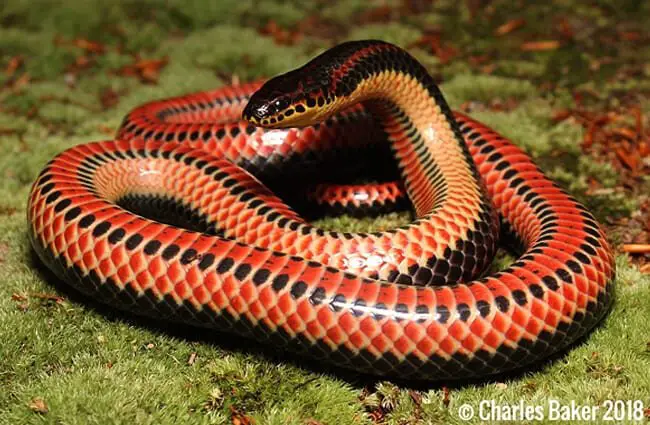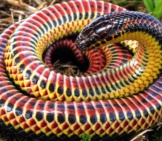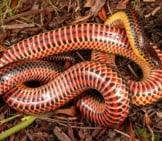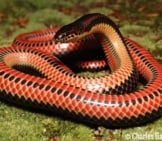The Rainbow Snake is a brightly colored, non-venomous species of snake. It lives in the southern United States. Its closest relative, the mud snake, also lives in the southern United States. Researchers place both species in the taxonomic genus Farancia. Read on to learn about the Rainbow Snake.
Description of the Rainbow Snake
The upper side of this species is darker and less colorful than the underside. Their scales are brown, red, yellow, and green. The upper side is dark brown or black with red stripes, while the underside is yellow, reds, and green.
They range in size from 36 to 48 in. long. However, some individuals reach lengths up to 66 in. or more.
Interesting Facts About the Rainbow Snake
This species is definitely interesting looking. Learn more about what makes these snakes unique below.
- Swimming Snake – This species spends most of its time in the water. It sticks to areas with lots of aquatic vegetations and other cover.
- Burrow Business – When the going gets tough, the tough get going – underground! These snakes often burrow into sand or mud to escape predators or search for food.
- Not-So Yellow-Bellied – When these snakes hatch, they have slightly different coloration than their adult counterparts. Adults have prolific yellow color on their underside, but as juveniles this yellow color is absent.
- Battle Royale – When breeding season arrives, males of this species grow quite aggressive towards one another. They fight to show the female which snake is strongest and best mate.
Habitat of the Rainbow Snake
These snakes are fond of aquatic habitats. Their favorite ecosystems include swamps, marshes, wetlands, streams, lakes, ponds, rivers, and creeks.
Within these habitats, they spend most of their time in aquatic vegetation, beneath fallen trees, in rotting logs and stumps, and more. They also live in forests, mountainous regions, and burrow deep underground.
Distribution of the Rainbow Snake
This species ranges throughout the southern United States. Their population extends north to Maryland, south to Florida, and into Louisiana to the west. You can also find this species in Georgia, South Carolina, North Carolina, Alabama, and Virginia.
Diet of the Rainbow Snake
When this snake is young, it eats frogs, worms, fish, salamanders, and tadpoles. Once it reaches adulthood, it specializes on a single type of prey, the American eel. Adults almost exclusively feed on these eels. They then climb out of the water to eat the eel and digest it.
Rainbow Snake and Human Interaction
The IUCN lists this species as Least Concern. However, that does not mean that human interaction doesn’t impact them. Populations in certain areas are in decline due to habitat destruction. In some areas, people also capture this snake for the pet trade.
Domestication
Humans have not domesticated this species in any way.
Does the Rainbow Snake Make a Good Pet
No, these snakes do not make good pets. It is illegal in most places to own this species as a pet.
Rainbow Snake Care
In zoos, these snakes live in watery enclosures with a variety of hiding places and basking locations. Though they feed exclusively on eels, some zoos have had success feeding small fish. Regardless, this species is not common in human care, and we know little of their needs in zoos.
Behavior of the Rainbow Snake
This species spends most of its time in the water, near the water, or burrowed underground. They are active at night and hide during the day, making them nocturnal. When captured, the species is practically harmless. It does not bite, but simply pokes its tail at its attacker’s skin. The tail is not pointed enough to injure in any way.
Reproduction of the Rainbow Snake
These snakes breed with multiple partners throughout a breeding season, and males fight to breed with females. After mating, the females lay a clutch of 10 – 52 eggs underground. The average number of eggs per clutch is approximately 20.
The female stays with the eggs until they hatch 2 or 3 months later. After hatching the female leaves, and the young receive no parental care. When the young snakes are 2 or 3 years old, they reach sexual maturity.









![Red Angus Closeup of a beautiful Red Angus cowPhoto by: U.S. Department of Agriculture [pubic domain]https://creativecommons.org/licenses/by/2.0/](https://animals.net/wp-content/uploads/2020/03/Red-Angus-4-238x178.jpg)












![Red Angus Closeup of a beautiful Red Angus cowPhoto by: U.S. Department of Agriculture [pubic domain]https://creativecommons.org/licenses/by/2.0/](https://animals.net/wp-content/uploads/2020/03/Red-Angus-4-100x75.jpg)

